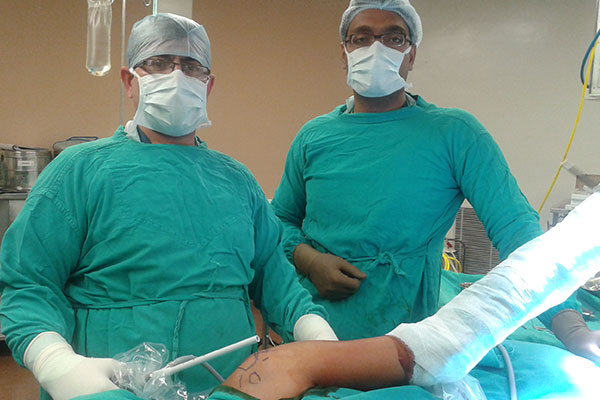Shoulder Arthroscopy
Anatomy

Shoulder is a complex joint that is capable of more motion than any other joint in your body. It is made up of three bones: upper arm bone (humerus), shoulder blade (scapula), and collarbone (clavicle).
Ball and Socket
The head of humerus bone fits into a rounded socket-glenoid in shoulder blade.. A slippery tissue called articular cartilage covers the surface of the ball and the socket. It creates a smooth, frictionless surface that helps the bones glide easily across each other.The glenoid is ringed by strong fibrous cartilage called the labrum. The labrum forms a gasket around the socket, adds stability, and cushions the joint.
Shoulder capsule
The joint is surrounded by bands of tissue called ligaments. They form a capsule that holds the joint together. The undersurface of the capsule is lined by a thin membrane called the synovium. It produces synovial fluid that lubricates the shoulder joint.
Rotator cuff
Four tendons surround the shoulder capsule and help keep arm bone centered in shoulder socket and they help move shoulder in different directions. The tendons in the rotator cuff can tear when they are overused or injured. The cuff covers the head of the humerus and attaches it to shoulder blade.
Bursa
There is a lubricating sac called a bursa between the rotator cuff and the bone on top of shoulder (acromion). The bursa helps the rotator cuff tendons glide smoothly when one move his arm.
Various conditions which require shoulder arthroscopy
Rotator Cuff Tear
This can be treated with either arthroscopy or open procedure. Which method is better, is controversial, it depends on the severity of tear and surgeons experience and comfort.
The edges of the muscles are brought together. The tendon is attached to the bone with sutures. Small suture anchors are often used to help attach the tendon to the bone. The anchors can be made of titanium or bioabsorable material .They do not need to be removed after surgery.
Shoulder Instability
Labral tears, such as Bankart tear & SLAP taer, are commonly treated with arthroscopy. The Bankart lesion is a tear on the labrum in the lower part of the shoulder joint. A SLAP lesion involves the labrum and the ligament on the top part of the shoulder joint.
It is very important that patients who have arthroscopic surgery for these procedures follow their post-operative rehab protocol very closely.
Impingement Syndrome
Patients with shoulder bursitis, also called impingement syndrome, that is not cured with simple treatments may consider a procedure called an arthroscopic subacromial decompression. This procedure removes the inflamed bursa and some bone from the irritated area around the rotator cuff tendons. By removing this tissue, more space is created for the tendons and the inflammation often subsides.
Biceps Tendonitis
The biceps tendon can become irritated and inflamed as an isolated problem or in association with problems such as impingement syndrome and rotator cuff tears. When the biceps tendon is damaged and causing pain, a procedure called a tenodesis can be performed. This procedure usually causes no functional difference, but often relieves symptoms.
Frozen Shoulder
Frozen shoulder seldom requires operative treatment, and treatment for many months or years is often necessary before considering operative treatment. When frozen shoulder must be treated surgically, it is of utmost importance to begin aggressive physical therapy immediately following surgery. Without this, it is likely the problem will return.
